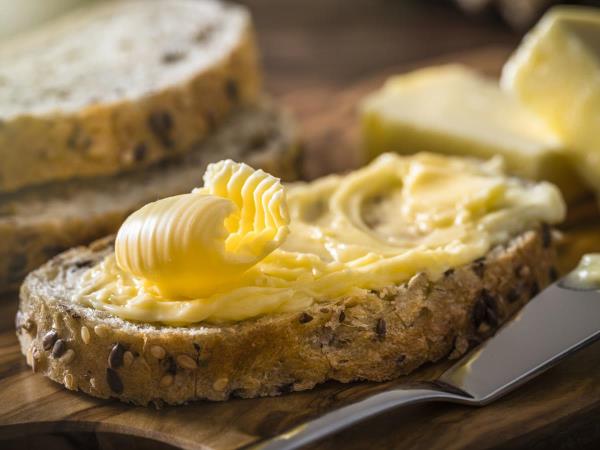The butter found on our shelves contains an average of 82% fat. This means that out of 100 grams of butter, 82 grams are fat. Most of this fat consists of saturated fatty acids, which play a crucial role in raising cholesterol levels in the blood, unfortunately not in a positive direction.
Saturated fats are harder for the body to process. Among them, two acids stand out: palmitic and myristic acid. The first is often associated with the development of cardiovascular diseases, while the second is linked to inflammation and clogged arteries. It's no longer a secret that regular consumption of large amounts of saturated fats carries an increased risk of elevated cholesterol, clogged arteries, and ultimately heart attacks or strokes.
According to the World Health Organization (WHO), an adult should consume a maximum of 10% of their daily calorie intake from saturated fats. With a standard intake of 2,000 calories, this means no more than 22 grams of saturated fats daily – and butter can quickly push you to that limit.
What Do Studies Say?
In one of the largest studies published by the Harvard School of Public Health in 2015, over 100,000 people were monitored for a 30-year period. They found that replacing saturated fats in the diet with unsaturated fats (such as those in olive oil or fish) reduces the risk of heart diseases by 14%. Even more interestingly, those who replaced saturated fats with complex carbohydrates (such as legumes, whole grains, and vegetables) reduced the risk by 25%.
Margarine – Solution or New Problem?
Decades ago, when researchers first warned about the dangers of butter, margarine emerged as a healthier alternative. Made from vegetable oils naturally high in unsaturated fats, which sounds good. However, things soon turned out to be more complicated.
The old method of producing margarine, called partial hydrogenation, led to the formation of trans fatty acids, fats that are even worse for our bodies than saturated fats. Their effect was so strong that they increased bad cholesterol (LDL) and decreased good cholesterol (HDL). This was a double blow to the heart and arteries.
According to a 2018 study published in the British Medical Journal, by reducing trans fats in the European diet, over 50,000 deaths from cardiovascular diseases could be prevented annually.
Good News? Nowadays, most margarine manufacturers have completely abandoned this method. Modern margarine no longer contains harmful trans fats and is often a better choice than butter. However, it's important to choose margarines low in saturated fats and free from trans fats. It's best to check the packaging label.
What about Light Margarine?
Light margarine with only 25% fat is available on the market. At first glance, it sounds excellent – less fat, fewer calories. But here's the catch: because it contains more water, we often use more of it. And so, we quickly exceed the amount we actually wanted to reduce.
Light margarine is still fat, so it should be used in moderation. If you are on a diet or watching your weight, opt for spreads made from avocado, hummus, or simply homemade cottage cheese spread with chives. They are higher in protein, lower in fats, and will keep you satisfied for longer.
Ghee – Treasure of Ancient India
Now onto something special. You may have heard of ghee, which has been increasingly popular in recent years. It is clarified butter that contains no water and milk proteins, making it stable at room temperature and excellent for frying. In Ayurvedic medicine – traditional healing originating from India – ghee has been used for over 2,000 years. Ayurveda values ghee for its purifying properties. It is used as a base for herbal preparations, skin care, and even in ocular therapies. Ghee is believed to aid digestion, strengthen immunity, and have a calming effect on the nervous system. It is a good source of vitamins A, D, E, and K, but still contains saturated fats, so the same rule applies: consume it moderately and thoughtfully.
What Would Our Ancestors Say?
It's true that our grandparents used to eat butter. But they weren't sitting in front of the TV. Their everyday life was strenuous – waking up at five in the morning, walking to the fields, working physically all day. They used up the energy from butter. Today, our lives are sedentary (on average, we sit for more than 9 hours a day).
Therefore, we must not be deluded that homemade food automatically benefits us. What was good then may not be necessarily good today. Our bodies have different needs now.
So What Do We Recommend?
If you want to maintain a healthy heart and well-being, we recommend consuming butter and margarine only occasionally and in smaller quantities. For breakfast, try whole grain bread with avocado, nuts, and fresh vegetables. Or prepare a homemade spread from beans, lentils, or cottage cheese – all of which are rich in proteins and fibers that aid digestion.
And if you do opt for margarine, choose one enriched with omega-3 fatty acids (which support brain and heart health) and containing as little saturated fats as possible. If you are looking for something more exotic, go for ghee, but make sure it is organically produced and additive-free.
Listen to Your Body
Our bodies always send us signals; we just need to listen to them. After eating butter, you may feel discomfort in your stomach, bloating, or lack of energy. All these are signs that something is out of balance. So listen to yourself and indulge in what truly nourishes you: not just physically, but also mentally.
And a Final Thought: Health is not about what we eat occasionally, but about what we eat every day. Therefore, let your breakfast be a thoughtful choice...
Datum: 23. JUN 25 - GOOD TO KNOW
Facts about Butter That Make Breakfast Less Appealing
If you are like most people, warm butter on freshly baked bread is probably something that brings back memories of childhood. But beware...
(FW)
 Would you like to be informed about news on the website?
Would you like to be informed about news on the website?
Just enter your e-mail
Saturated fats
Butter dangers
Unsaturated fats
Healthy spreads
Margarine alternatives
|
Copyright (c) Foodwhisper.com March 2018 |
π | Contact: info@foodwhisper.com |
About us | Facebook |  |









